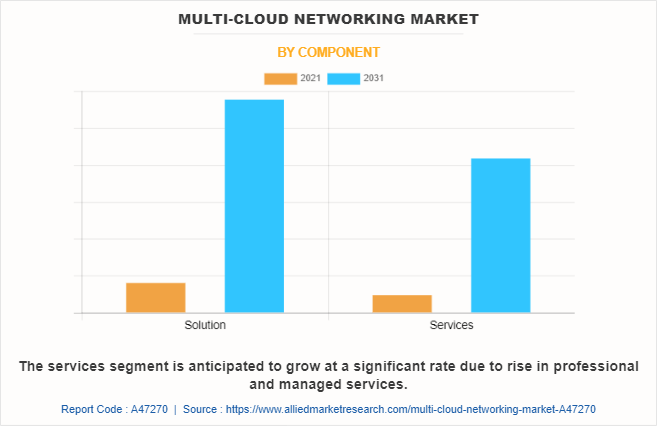Multi-Cloud Networking Market Statistics: 2031
The global multi-cloud networking market size was valued at $2.5 billion in 2021, and is projected to reach $19.9 billion by 2031, growing at a CAGR of 23.3% from 2022 to 2031.
Factors such as increase in adoption of multi-cloud networking solutions and services and rise in demand for data recovery along with contingency planning are projected to drive the growth of the multi-cloud networking market during the forecast period. Moreover, increase in adoption of cloud computing and rise in internet penetration boost the market growth. However, concerns associated with data security and privacy protection and lack of technical expertise in multi-cloud networking restrain the market growth. On the contrary, surge in demand for cloud-based networking solutions and rise in number of SMEs are projected to provide major lucrative opportunities for the growth of the multi-cloud networking market.

Multi-cloud networking is the orchestration of cloud service delivery and the extension of cloud services from one enterprise data center to another. By leveraging multiple clouds, businesses can enjoy a host of benefits, including increased agility, improved performance and enhanced disaster recovery.
Multi-cloud is not the same as hybrid cloud, which blends the use of private and public cloud environments. Rather, multi-cloud takes a mixed approach, using the best services from various providers to create a custom solution for an organization’s specific needs. This approach allows organizations to take advantage of the latest innovations from each vendor while avoiding vendor lock-in and ensuring maximum flexibility. Multi-cloud networking can be complex, but it provides a powerful way to build a custom, scalable and highly-available cloud infrastructure.
Top Impacting Factors
Need for Disaster Recovery and Contingency Plan
With the rising IT consumerization and the increased usage of computing devices, the rate of data generation has increased multifold. Multi-cloud disaster recovery entails storing data with more than one cloud vendor. Moreover, multi-cloud backups can be as simple as sending data to multiple provider, such as Google clod platform or Amazon AWS, for many organizations. In addition, cloud disaster recovery is a cloud computing service that allows system data to be stored and recovered on a remote cloud-based platform. Users need to store important documents, files, and other information as a backup in case of contingencies.
Furthermore, since individual users cannot afford expensive hardware for storing data as a backup, there is a need for low cost, personal storage services. Thus, users having a limited budget use the multi-cloud networking to store, access, and share data from anywhere using any device, thereby encouraging the growth of this market. These are the major driving factors for the multi-cloud networking market growth.
Increasing Deployment of Cloud Service Providers (CSPs)
As more organizations move to the cloud, they need to be proactive in securing their cloud applications, and multi-cloud networking provides a comprehensive level of visibility, compliance, and data security for the cloud transformation of the organization. Moreover, due to the explosive rate of enterprises moving toward the use of cloud service providers (CSPs), organizations are seeking new methods and best practices to implement security controls in cloud environments.
In addition, many key players are enhancing their services to provide security for sensitive enterprise information. For instance, in February 2022, F5 launched application security and delivery offerings, a range of solutions built on distributed cloud services for more security. The goal is to streamline security and bring automation within processes to allow application teams to focus on the delivery of functionality and features to improve customer experience. Such factors are anticipated to fuel the growth of multi-cloud networking market in the near future.
Limited Technical Expertise Among Enterprises
Enterprises are rapidly moving toward digitalization by adopting emerging technologies to automate and accelerate cloud has become an essential part of enterprises IT strategy, due to its benefits such as low costs and enhanced business agility. Moreover, the adoption of cloud computing services increases the demand for technically skilled labor and efficient change management to effectively implement and run cloud services in enterprises. These days, enterprises are more focused on driving profits rather than upgrading employee skills by providing appropriate training.
In addition, companies are resistant to adopting the maturation process and willing to stick to traditional infrastructures or software services to avoid initial costs. These factors result in skills shortage and may lead to business saturation. Therefore, these factors might lead to customer profit and loss for companies not adopting new changes and would enable competitors to increase their market shares and customer base.
Rise in Number of SMEs for Adoption of Multi-cloud Networking
SME’s face budget constraints and constantly struggle to make regulatory needs. Moreover, it is difficult for SME’s to efficiently focus on every business activities, as they have smaller IT teams and face a shortage of skilled employees. These complications are compelling SME’s to adopt cloud computing services, as they help in easily meeting regulatory needs, lowering capital expenditure (CAPEX) and operating expenditure (OPEX), enhancing security, increasing storage and flexibility and automating software updates and business tasks, leading to improved employee productivity.
In addition, advantages such as scalability, as pay-as-you- go and easy access to information are helping SME’s to access and use cloud services in a faster way. These factors are creating new opportunities for cloud vendors in the market. Therefore, these factors will provide major lucrative opportunities in the growth of the multi-cloud networking market share.
Segment Review
The multi-cloud networking market is segmented on the basis of component, deployment mode, enterprise size, and industry vertical. By component, it is segmented into solution and services. On the basis of deployment mode, the market is segmented into private cloud and public cloud. By enterprise size, it is bifurcated into larger enterprise and small & medium enterprise. By industry vertical, it is segmented into BFSI, IT & telecom, retail & e-commerce, healthcare, manufacturing, media & entertainment, energy & utilities, and others. By region, it is analysed across North America, Europe, Asia-Pacific, and LAMEA.

Based on component, the solution segment is the highest growing segment in 2021. This is attributed to the rise in number of adoption rate of multi-cloud networking techniques in end users such as BFSI and manufacturing. However, the services segment is expected to witness highest growth in multi-cloud networking industry during the forecast period, owing to rise in adoption of managed and professional cloud services.

Based on region, North America was the highest revenue contributor in 2021. This is attributed to the presence of key players in the region and technological advancements in the region. However, Asia-Pacific is expected to witness highest growth rate in multi-cloud networking industry during the forecast period, owing to rapid expansion of internet infrastructure across the region.
COVID-19 Analysis
The COVID-19 pandemic has played a key role in increasing the demand for multi-cloud networking solutions. The outbreak of the pandemic and the subsequent government restrictions have increased the demand for the latest advanced digital technologies and robust networks. Realizing that choosing a cloud-based infrastructure gives them an edge over their competitors, organizations are increasingly moving their workloads to the cloud, thereby increasing the demand for multi-cloud networking solutions. So, COVID-19 had positive impact on the multi-cloud networking market forecast.
Key Benefits for Stakeholders
- This report provides a quantitative analysis of the market segments, current trends, estimations, and dynamics of the multi-cloud networking market analysis from 2021 to 2031 to identify the prevailing multi-cloud networking market opportunities.
- The multi-cloud networking market research is offered along with information related to key drivers, restraints, and opportunities.
- Porter's five forces analysis highlights the potency of buyers and suppliers to enable stakeholders make profit-oriented business decisions and strengthen their supplier-buyer network.
- In-depth analysis of the multi-cloud networking market segmentation assists to determine the prevailing market opportunities.
- Major countries in each region are mapped according to their revenue contribution to the global multi-cloud networking market.
- Market player positioning facilitates benchmarking and provides a clear understanding of the present position of the market players.
- The report includes the analysis of the regional as well as global multi-cloud networking market trends, key players, market segments, application areas, and market growth strategies.
Multi-Cloud Networking Market Report Highlights
| Aspects | Details |
| Market Size By 2031 | USD 19.9 billion |
| Growth Rate | CAGR of 23.3% |
| Forecast period | 2021 - 2031 |
| Report Pages | 245 |
| By Component |
|
| By Enterprise Size |
|
| By Deployment Mode |
|
| By Industry Vertical |
|
| By Region |
|
| Key Market Players | Citrix Systems, Inc., Oracle, F5, Inc., Cloudflare, Inc., Hewlett Packard Enterprise Development LP, akamai technologies, Nutanix, VMware, Inc., Cisco Systems, Inc., Juniper Networks, Inc. |
Analyst Review
Multi-cloud networking is a cloud computing architecture in which an organization distributes applications and services across several clouds, which may include two or more private clouds, two or more public clouds, or a blend of public, private, and edge clouds. Furthermore, multi-cloud networking helps to avoid lock-ins with one vendor and also provides a high-speed low-latency infrastructure with better resilience.
The global multi-cloud networking market is expected to register high growth as it expedites the next phase of digital transformation; businesses are leveraging multiple cloud services and platforms to speed up app transformation as well as the delivery of new applications. Thus, increase in adoption of cloud technology, owing to its security is one of the most significant factors driving the growth of the market. With surge in demand for multi-cloud networking in fintech, various companies have established alliances to increase their capabilities. For instance, in February 2,022, U.S. Bank Corporation partnered with Microsoft Corporation to create compelling, personalized and leading-edge experiences to improve the security of data, financial assets and customer privacy by adding resiliency for the bank and strengthening technology risk management.
In addition, with further growth in investment across the world and the rise in demand for multi-cloud networking, various companies have expanded their current product portfolio with increased diversification among customers. For instance, in August 2020, the Laurentian Bank of Canada partnered with Kyndryl for a new cloud landing zone, leveraging cloud platforms such as Microsoft Azure. With this new environment, the bank will have its digital services function efficiently and securely, which will in turn allow its customers to benefit from an optimal and seamless experience at all interaction touchpoints.
Moreover, with an increase in competition, major market players have started acquiring companies to expand their market penetration and reach. For instance, in December 2,020 IBM acquired Expertus Technologies Inc to strengthen IBM Payments Centre capability in Canada and add further value to clients and the financial services industry.
The global multi-cloud networking market was valued at $2.50 billion in 2021, and is projected to reach $19.88 billion by 2031, registering a CAGR of 23.3% from 2022 to 2031.
Factors such as increase in adoption of multi-cloud networking solutions and services and rise in demand for data recovery along with contingency planning are driving the multi-cloud networking market growth during the forecast period.
North America is the largest regional Market in Multi-Cloud Networking Market.
Akamai Technologies, Cisco Systems, Inc., Citrix Systems, Inc., Cloudflare, Inc., F5, Inc., Hewlett Packard Enterprise Development LP, Juniper Networks, Inc., Nutanix, Oracle, and VMware, Inc.
The key growth strategies for digital media production software market include product portfolio expansion, acquisition, partnership, merger, and collaboration.
Loading Table Of Content...
Loading Research Methodology...



